World agriculture towards 2030/2050: the 2012 revision - Fao
World agriculture towards 2030/2050: the 2012 revision - Fao
World agriculture towards 2030/2050: the 2012 revision - Fao
You also want an ePaper? Increase the reach of your titles
YUMPU automatically turns print PDFs into web optimized ePapers that Google loves.
PROOF COPY<br />
endowments. Since <strong>the</strong>y have to depend predominantly on own production for food supplies,<br />
it is difficult to visualize a situation whereby <strong>the</strong>y raise national average per capita food<br />
consumption to levels that ensure that no segment of <strong>the</strong>ir population will have per capita<br />
food below minimum requirements for good nutrition.<br />
As all statements about possible future states of <strong>the</strong> world, our projections are subject to<br />
many uncertainties. Some of <strong>the</strong>m, specific to food security outcomes, all referring to<br />
downside risks, are worth listing here.<br />
• Successive <strong>revision</strong>s of <strong>the</strong> population projections suggest that some negative aspects of<br />
population growth may be more serious than incorporated in this study. It is not so<br />
much that projected global population may turn out to be higher (9.3 billion in <strong>2050</strong> in<br />
<strong>the</strong> 2010 release of <strong>the</strong> UN projections) than <strong>the</strong> 9.15 billion assumed in <strong>the</strong> projections<br />
used here (from <strong>the</strong> 2008 release). The additional food required could be easily<br />
produced globally. The problem is that all of <strong>the</strong> increment and some more (206<br />
million) originates in upward <strong>revision</strong>s in <strong>the</strong> projected population of sub-Saharan<br />
Africa. This does not augur well for <strong>the</strong> food security prospects of <strong>the</strong> region and <strong>the</strong><br />
world. The improvements projected in this study may turn out to be too optimistic if <strong>the</strong><br />
new population projections materialized.<br />
• Climate change may also affect adversely <strong>the</strong> prospect of achieving <strong>the</strong> food security<br />
improvements projected in this study. Most climate models indicate that <strong>the</strong> agricultural<br />
potential of <strong>the</strong> developing countries may be more adversely affected than <strong>the</strong> world<br />
average. The high dependence of several of <strong>the</strong>m on <strong>agriculture</strong> makes <strong>the</strong>m particularly<br />
vulnerable in this respect. Studies that have looked into this matter provide very<br />
disparate answers ranging from catastrophic to mildly pessimistic (see Alexandratos,<br />
2011b for a critical evaluation of such findings as of 2009).<br />
• Finally, <strong>the</strong> increased integration between <strong>agriculture</strong> and <strong>the</strong> energy market fostered by<br />
<strong>the</strong> growing use of crops in biofuels production represents a potential disrupting element<br />
in <strong>the</strong> future. Much of <strong>the</strong> biofuels production in some of <strong>the</strong> major producing countries<br />
is currently driven by mandates and subsidies. However, should economic realities<br />
dictate and energy prices increase significantly, biofuels may become competitive<br />
without support policies. The option that biofuels could expand only into land not<br />
suitable for food crop production is not tenable in an environment of laissez-faire<br />
markets. Given <strong>the</strong> disproportionately large size of <strong>the</strong> energy markets relative to those<br />
for food and <strong>the</strong> stronger economic position of those demanding more energy vs. those<br />
needing more food, care must be taken to protect access to food by vulnerable<br />
population groups in <strong>the</strong> face of rising food prices. At <strong>the</strong> same time, it must be<br />
recognized that judiciously expanded biofuels sector has <strong>the</strong> potential of benefiting<br />
development in countries with abundant resources suitable for <strong>the</strong> production of biofuel<br />
feedstocks.<br />
What’s next? Beyond <strong>2050</strong><br />
Imagine you are in <strong>2050</strong> and <strong>the</strong> projections we have presented have come true. How should<br />
we speculate about future developments, say to 2100? Can our conclusions for <strong>the</strong> projection<br />
period to <strong>2050</strong> provide some clues as to what may be in store beyond <strong>2050</strong>?<br />
Looking at global magnitudes first, <strong>the</strong> slowdown in world population growth was a<br />
major reason why we concluded that <strong>the</strong>re will be lower growth in world <strong>agriculture</strong> in <strong>the</strong><br />
period to <strong>2050</strong> compared with <strong>the</strong> past. The same demographic projections employed in this<br />
paper – 2008 release, Medium Variant – suggest that <strong>the</strong> slowdown is to accelerate beyond<br />
19









